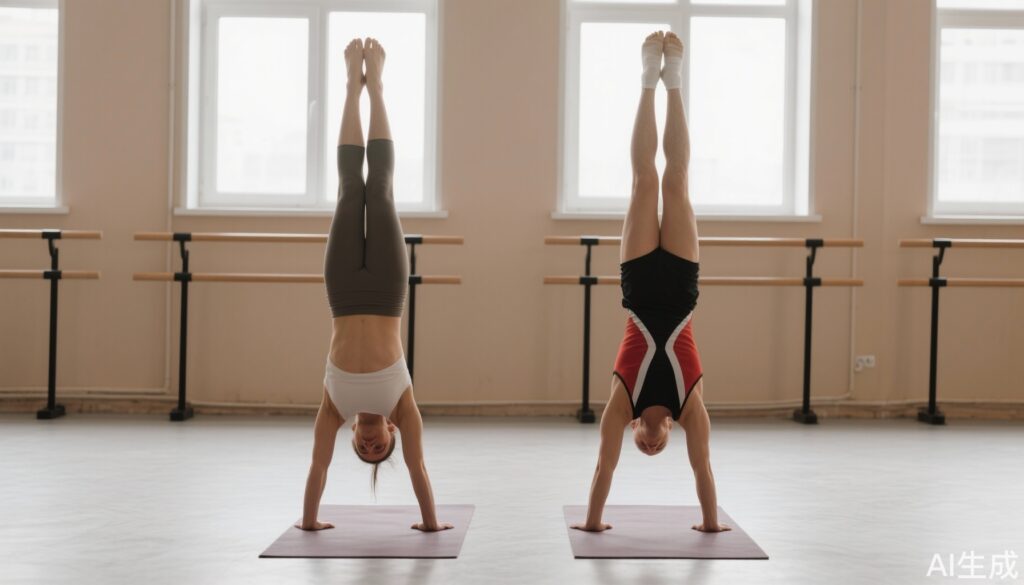Introduction
Handstands showcase both strength and balance, serving as a bridge between physical prowess and body awareness in multiple disciplines. Notably, handstands feature prominently in yoga and gymnastics—two fields that embrace this inversion, yet with distinct approaches and philosophies. In yoga, the handstand, known formally as Adho Mukha Vrksasana, is an intermediate pose demanding balance and mindfulness. In contrast, gymnastics and related practices, including calisthenics, incorporate handstands as foundational elements of dynamic routines and athletic performance. This article delves into the scientific, biomechanical, and cultural differences between yoga and gymnastics handstands, providing insights for practitioners, clinicians, and enthusiasts alike.
Handstands in Yoga: Crafting Balance and Awareness
The yoga handstand typically begins from the ground with a kick-up technique. This entry is often less intimidating for beginners because it reduces the margin of error compared to more forceful launches. Its success hinges not only on strength but also on flexibility—especially the elasticity in the back—since the legs generate minimal force. Yogic practice emphasizes a “stacked” body alignment, where the body is perfectly straight from wrists to toes, resembling a vertically stacked column. This posture allows muscles to rest on locked joints, similar to standing with locked knees, thereby reducing muscular exertion required to maintain the pose.
The measured approach aligns with yoga’s broader emphasis on self-awareness, control, and sustained balance. Unlike gymnastics’ more hollow shape, where the center of gravity sits slightly outside the body’s vertical axis, yoga requires a centered balance to cultivate calm and mindfulness. Practicing this pose improves proprioception, upper-body strength, and flexibility, offering both physical and mental benefits.
Handstands in Gymnastics and Calisthenics: Dynamic Momentum and Strength
Gymnastics employs handstands as fundamental building blocks within complex routines. Unlike the static yoga entry, gymnasts initiate handstands from a standing position, using controlled momentum. By lunging forward and positioning their hands near the lead foot, gymnasts generate “heel drive” from the lagging leg. This leg swings in a precise, circular arc that produces momentum, which assists in lifting the body effortlessly into a handstand.
This dynamism requires excellent timing and coordination to avoid tipping forward. Gymnastics also features various press-to-handstand variations, such as the standard press, pike press, and wide-arm press. These techniques involve gradually shifting the center of gravity over the hands by leaning forward and lifting the feet smoothly in an arch before returning them together at the top of the position. The slightly hollow form favored by gymnasts involves keeping the arms locked but shifting the center of gravity to maintain balance over the hands, optimizing control during dynamic sequences.
Comparison of Handstand Forms and Techniques
| Aspect | Yoga Handstand (Adho Mukha Vrksasana) | Gymnastics/Calisthenics Handstand |
|—————————|——————————————–|———————————————–|
| Entry Technique | Kick-up from the ground, slower, controlled| Standing lunge with heel drive, dynamic momentum|
| Body Posture | Completely stacked and straight | Slightly hollow, with shifted center of gravity|
| Joint Positioning | Locked joints for stability | Locked arms, with controlled hollow shape |
| Focus | Balance, self-awareness, flexibility | Power, momentum, endurance |
Understanding these biomechanical and technical differences can guide practitioners on which handstand style suits their goals and physical capacities.
Handstands: Floor vs. Paralettes in Practice
In yoga, handstands are primarily performed directly on the floor. This gives the practitioner the ability to manipulate balance through finger positioning and wrist articulation. By contrast, gymnastics and calisthenics often utilize paralettes or parallel bars for handstand practice. These apparatuses reduce wrist extension requirements, distributing weight more evenly and allowing enhanced wrist control.
Practicing handstands on paralettes may be less taxing on the wrists, which is particularly beneficial for individuals who experience wrist pain performing floor handstands. Moreover, parallel bars enable transitions into other skills and improve shoulder and forearm strength important for gymnastic sequences.
Clinical and Biomechanical Insights
From a clinical perspective, the differing handstand techniques impart varied stresses on joints, muscles, and balance systems. Yoga handstands prioritize core stability and spinal extension flexibility, potentially benefiting proprioception and mindfulness. Gymnastics handstands demand power generation and neuromuscular coordination to manage momentum and balance dynamically.
Research indicates that handstand practice can enhance upper-body neuromuscular control and balance (Behm & Anderson, 2017). However, incorrect technique or inadequate preparation can increase risks of wrist injuries or falls. Utilizing proper progression, such as strength conditioning and wrist mobility exercises common in both disciplines, is crucial to minimize injury risk.
Challenges and Common Misconceptions
A frequent misconception is that all handstands are identical across disciplines. However, subtle differences in entry, posture, and intent make a significant impact on technique and outcomes. For instance, attempting a gymnastics-style handstand without sufficient momentum or strength may lead to instability or injury.
Some practitioners wrongly assume more forceful kick-ups are universally advisable, disregarding individual flexibility and control—an approach contrary to yoga’s emphasis on mindful, balanced movement.
Practical Recommendations for Practitioners
– Assess your goals: Whether adopting yoga’s mindful control or gymnastics’ dynamic power, choose techniques that align with your training objectives.
– Progress gradually: Focus on building shoulder strength, wrist mobility, and core stability before attempting full handstands.
– Use appropriate equipment: For wrist pain, using paralettes may alleviate discomfort and facilitate safer practice.
– Seek guidance: Especially for beginners, expert coaching can ensure correct technique and reduce injury risks.
Expert Perspectives
Dr. Lisa Smith, a sports medicine physician, notes: “Handstands are excellent tools for developing strength and proprioception, but their safety depends on technique fidelity and individualized progression. Yoga handstands underscore control and body awareness, which can aid rehabilitation, whereas gymnastics handstands develop explosive power and balance.”
Yoga instructor and physical therapist Michael Chen adds, “Understanding the distinct mechanics and breathing patterns in yoga handstands helps avoid compensatory injuries and promotes lasting joint health.”
Patient Scenario
David, a 28-year-old recreational athlete, approached his physical therapist to improve upper-body strength and balance. Interested in handstand training, he initially tried gymnastics-style handstands but struggled with wrist discomfort and inconsistent balance. After evaluation, his therapist recommended starting with yoga-style handstands focusing on controlled kick-ups and engaging in wrist mobility exercises. Over weeks, David gained better balance awareness and wrist tolerance, later incorporating paralettes to ease strain. This tailored approach minimized injury risk and enhanced his confidence in progression.
Conclusion
Although handstands appear similar across disciplines, yoga and gymnastics adopt uniquely different methods reflecting their underlying philosophies. Yoga’s Adho Mukha Vrksasana emphasizes balance, alignment, and self-awareness with a stacked form performed from the floor. Gymnastics handstands prioritize power, momentum, and dynamic control, entering from standing and often using equipment like paralettes. Awareness of these differences benefits practitioners in selecting suitable training styles, while clinicians can leverage this knowledge for injury prevention and rehabilitation guidance. Future research may elucidate detailed biomechanical impacts and optimize training protocols across various handstand practices.
References
Behm, D. G., & Anderson, K. (2017). The role of balance training in injury prevention and performance enhancement. Journal of Sports Rehabilitation, 26(3), 257-275. https://doi.org/10.1123/jsr.2017-0055
Sonthalia, S., & Scott, A. (2014). Wrist injuries in gymnasts: A clinical review. Current Sports Medicine Reports, 13(3), 163-170. https://doi.org/10.1249/JSR.0000000000000060
Brown, B. (2016). Yoga anatomy. Human Kinetics.
Anderson, L. (2021). Calisthenics and gymnastics: Developing strength and balance. Strength and Conditioning Journal, 43(5), 28-37.


